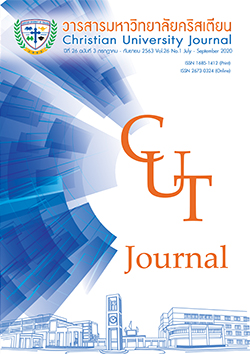การทดสอบการเดิน 1 นาทีในเด็กสมองพิการ: งานวิจัยเชิงสำรวจ ณ มูลนิธิอนุเคราะห์ คนพิการในพระราชูปถัมภ์ของสมเด็จพระศรีนครินทราบรมราชชนนี
คำสำคัญ:
สมองพิการ, กล้ามเนื้อแข็งเกร็ง, การเดินบทคัดย่อ
งานวิจัยนี้มีวัตถุประสงค์เพื่อศึกษาความสามารถของการเดินในผู้ป่วยเด็กสมองพิการ งานวิจัยนี้เป็นงานวิจัยเชิงสำรวจ สุ่มกลุ่มตัวอย่างแบบเฉพาะเจาะจง กลุ่มตัวอย่างเป็นผู้ป่วยเด็กสมองพิการที่รับการรักษาและฟื้นฟูที่มูลนิธิอนุเคราะห์คนพิการในพระราชูปถัมภ์ของสมเด็จพระศรีนครินทราบรมราชชนนี (มูลนิธิอนุเคราะห์คนพิการ) เครื่องมือประกอบด้วยแบบสอบถามข้อมูลส่วนบุคคลและการทดสอบความสามารถของการเดิน 1-minute walk test ซึ่งมีค่าความเที่ยงสูง (intraclass correlation coefficient = 0.86 – 0.96) ผลการศึกษาพบว่ากลุ่มตัวอย่างจำนวน 40 คน อายุระหว่าง 8 – 14 ปี มีความสามารถด้านการเคลื่อนไหว (Gross Motor Function Classification System: GMFCS) อยู่ในระดับ II และ III ผลการทดสอบความสามารถของการเดินด้วย 1-minute walk test พบว่ามีกลุ่มตัวอย่างเดินได้ระยะทางค่าเฉลี่ย 55.71 เมตร กลุ่มตัวอย่างที่เดินได้ระยะทางไกลที่สุดเท่ากับ 86 เมตรและมีความสามารถด้านการเคลื่อนไหว (GMFCS) ระดับ II ในขณะที่กลุ่มตัวอย่างที่เดินได้ระยะทางใกล้ที่สุดเท่ากับ 32 เมตรและมีความสามารถด้านการเคลื่อนไหว (GMFCS) ระดับ III ผลการศึกษานี้มีประโยชน์ต่อผู้ปกครองและผู้ดูแลผู้ป่วยเด็กสมองพิการในการทราบความสามารถของการเดินและเป็นประโยชน์ต่อมูลนิธิอนุเคราะห์คนพิการสำหรับใช้เป็นข้อมูลเพื่อวางแผนการจัดกิจกรรมและจัดสิ่งแวดล้อมที่อำนวยความสะดวกต่อการทำกิจวัตรประจำวันตามความสามารถของผู้ป่วย
เอกสารอ้างอิง
พรรณี ปึงสุวรรณ, ปภัสรา หาญมนตรี, ปริญญาทิพย์ ทองด้วง, ธิดารัตน์ เจือมประโคน, พิสมัย มะลิลา และสุกัลยา อมตฉายา. (2555). ความเที่ยงของการทดสอบการเดิน 1 นาทีในเด็กสมองพิการ. วารสารเทคนิคการแพทย์และกายภาพบำบัด, 24(1), 87-96
มูลนิธิอนุเคราะห์คนพิการ ในพระราชูปถัมภ์ของสมเด็จพระศรีนครินทราบรมราชชนนี. (2562). ประวัติมูลนิธิฯ. สืบค้นจาก http://www.fwc1954.org/history/history01.html
ศรีนวล ชวศิริ, กมลทิพย์ หาญผดุงกิจ, ชยาภรณ์ โชติญาณวงษ์, วรธีร์ เดชารักษ์ (บรรณาธิการ). (2560). รู้ทาง ...เวชศาสตร์ฟื้นฟูเด็ก. กรุงเทพฯ: บริษัท พี.เอ.ลีฟวิ่ง จำกัด.
Eek, MN., Beckung E. (2008). Walking ability is related to muscle strength in children with cerebral palsy. Gait & Posture, 28, 366-371.
Guyatt, GH., Sullivan, MJ., Thompson, PJ., Fallen, EL., Pugsley, SO., Taylor, DW., Berman, LB. (1985). The 6-minute walk: a new measure of exercise capacity in patients with chronic heart failure. Canadian medical association journal, 132(8), 919-923
Huang, IC., Sugden, D., & Beveridge, S. (2009). Assistive devices and cerebral palsy: Factors influencing the use of assistive devices at home by children with cerebral palsy. Child: Care, Health and Development, 35(1), 130-139.
Johnston TE., Moore SE., Quinn LT., Smith BT. (2004). Energy cost of walking in children with cerebral palsy: relation to the Gross Motor Function Classification System. Developmental Medicine & Child Neurology. 46, 34-38.
Katz-Leurer, M., Rotem, H., Keren, O., & Meyer, S. (2009). Balance abilities and gait characteristics in post-traumatic brain injury, cerebral palsy and typically developed children. Developmental Neurorehabilitation, 12(2), 100-105.
Krejcie, R. V., & Morgan, D. W. (1970). Determining sample size for research activities. Educational and Psychological Measurement, 30(3), 607-610.
Levine, D., Richards, J., & Whittle, M. W. (2012). Whittle's gait analysis-E-book. Sydney: Elsevier Health Sciences.
Lintanf, M., Bourseul, J., Houx, L., Lempereur, M., Brochard, S., & Pons, C. (2018). Effect of ankle-foot orthoses on gait, balance and gross motor function in children with cerebral palsy: A systematic review and meta-analysis. Clinical Rehabilitation, 32(9), 1175-1188.
Maher, C. A., Williams, M. T., & Olds, T. S. (2008). The six-minute walk test for children with cerebral palsy. International Journal of Rehabilitation Research, 31(2), 185-188.
McDowell, B. C., Kerr, C., Parkes, J., & Cosgrove, A. (2005). Validity of a 1 minute walk test for children with cerebral palsy. Developmental Medicine and Child Neurology, 7(11), 744-748.
McDowell, B. C., Humphreys, L., Kerr, C., & Stevenson, M. (2009). Test–retest reliability of a 1-min walk test in children with bilateral spastic cerebral palsy (BSCP). Gait & Posture, 29(2), 267-269.
Nolan, K. J., Savalia, K. K., Lequerica, A. H., & Elovic, E. P. (2009). Objective assessment of functional ambulation in adults with hemiplegia using ankle foot orthotics after stroke. PM&R, 1(6), 524-529.
Østensjø, S., Carlberg, E. B., & Vøllestad, N. K. (2003). Everyday functioning in young children with cerebral palsy: functional skills, caregiver assistance, and modifications of the environment. Developmental medicine and child neurology, 45(9), 603-612.
Ries, A. J., Novacheck, T. F., & Schwartz, M. H. (2015). The efficacy of ankle-foot orthoses on improving the gait of children with diplegic cerebral palsy: A multiple outcome analysis. PM&R, 7(9), 922-929.
Rosenbaum, P., Paneth, N., Leviton, A., Goldstein, M., Bax, M., Damiano, D., Dan, B., Jacobsson, B. (2007). A report: the definition and classification of cerebral palsy April 2006. Developmental medicine and child neurology. Supplement, 109,8-14.
Solway, S., Brooks, D., Lacasse, Y., & Thomas, S. (2001). A qualitative systematic overview of the measurement properties of functional walk tests used in the cardiorespiratory domain. Chest, 119(1), 256-270.



